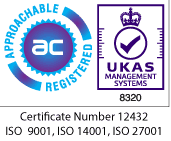The Best of Both Worlds: Maintain the Human Edge in AI Procurement
Procurement, like many other sectors, is currently being transformed by AI technologies. Organisations are rapidly adopting AI solutions to enhance efficiency, reduce costs, and gain a competitive advantage in their procurement processes.
According to recent research by Economist Impact, AI tools are already helping procurement professionals at 64% of firms, with larger organisations leading this digital transformation [7].
However, given the challenges of effectively implementing AI tools and their tendency to produce inaccurate or misleading outputs, it is essential for organisations to critically assess the immediate value of this technology, the costs involved in its deployment, and the potential impact on procurement teams.
This article explores the user cases of AI in procurement, the emergence of Agentic AI, implementation challenges and strategies, and how Cambridge Management Consulting can guide you through this complex process and over the hurdles.
We also stress that AI in procurement is not a panacea — it can be leveraged successfully for certain user cases when it is integrated with the support of well-trained teams who can spot errors and who understand the limits of these tools.
Let's Start with the Limits
AI, despite the marketing hype in the media, is not yet a ‘silver bullet’ or an all-encompassing fix when it comes to procurement. It will not solve everything on day one, but it will change how a procurement function operates and will no doubt drive efficiency alongside data accuracy and linkage. Now, more than ever, having a skilled Procurement team alongside cutting-edge technologies like AI is essential for unlocking new efficiencies and elevating procurement to the next level.
AI will make a procurement team even more data driven in their analysis and decision making. AI tools will allow procurement teams to sift through vast amounts of data quickly and will draw conclusions for review and assessment. The power of being data driven should not be underestimated and as the American composer and economist W. Edwards Deming once said,
“Without data, you’re just another person with an opinion, […] in God we trust; all others bring data” [22].
Each and every organisation must carefully consider how to leverage AI-generated data effectively. While AI can enhance procurement processes, an experienced procurement team remains essential for defining and prioritising key challenges, navigating contract negotiations, and implementing structured cost-reduction strategies.
The human touch — particularly in managing and driving commercial supplier relationships — will continue to be a vital component of procurement. While relationship management may not be the single most important aspect of supplier management, it is undeniably critical. It encompasses relationship-building, communication, collaboration, and trust: elements that are fundamental to maximising supplier value and mitigating risks.
Supplier management is more than just overseeing transactions; it demands a proactive approach that fosters strong partnerships. AI can revolutionise data management, but it must be complemented by the human expertise that ensures strategic decision-making, relationship stewardship, and long-term supplier success.
One could argue that it is easy to get lost in an AI discussion or defining a procurement strategy, but bottom-line supplier relationship management is critical and integral for any procurement department to be successful. If you cannot build, leverage and maintain relationships, you shouldn’t be at the table.
The Current State of AI in Procurement
Generative AI (GenAI) is having the same disruptive effect in procurement that it is in many other business areas, initially by completing quite simple tasks with incredible speed, accuracy and efficiency. This includes automating routine tasks, providing actionable insights from data sets, and freeing up time for your teams to focus on higher-level tasks such as managing processes and vendor relationships.
Below we highlight which tasks can be successfully enhanced or supported by AI.
AI-Powered Procurement Automation
For business leaders, AI is the tireless digital assistant that procurement teams have long needed. By automating tedious tasks like purchase order processing, linking third-party costs back to revenue services to strive for gross margin clarity, invoice management, and contract administration, AI frees professionals to focus on strategic initiatives. The impact is substantial: according to recent data, 45% of AI investments in procurement are focused on contract automation, highlighting organisational priorities for efficiency improvement and error reduction [1].
Real-world implementation has shown significant results. For example, a global manufacturing company deployed AI to automate invoice processing, reducing errors by 80% and cutting processing time by half [1].
Data-Driven Decision-Making
AI spares procurement from wading through hours of paperwork, a process that is time-consuming and prone to cascades of errors. Rather than being overwhelmed by huge data sets and unsure on which useful information to extract, AI does this with much more precision and many orders of speed.
With AI-driven analytics, procurement teams can manage and link multiple data sets, identify trends, and make more informed purchasing decisions in real time. McKinsey reports that procurement leaders implementing AI-driven analytics have accelerated supplier selection by 30%, demonstrating the significant impact on workflow efficiency [1].
The Rise of Agentic AI in Procurement
While traditional AI has already made significant inroads in procurement, a more advanced form — Agentic AI — is now emerging as a step-change for the profession.
What is Agentic AI?
Agentic AI represents the next phase in artificial intelligence models. Unlike previous automation tools that require human oversight for key decisions, AI agents can operate independently, leveraging machine learning, predictive analytics, and natural language processing to interact with suppliers, assess risks, and optimise sourcing strategies with minimal supervision[4].
According to The Hackett Group's 2025 Procurement Agenda and Key Issues Study, Agentic AI is the top trend impacting procurement this year, alongside digital procurement and automation[4]. The technology is expected to disrupt nearly 50% of procurement activities over the next five to seven years, creating entirely new opportunities for strategy[4]. The outlook for procurement teams might be more climatic, depending on the consistency and accuracy of Agentic AI. These models will be capable of independent reasoning and it currently unclear how close this will bring us to Artificial General Intelligence (AGI).
Adoption Trends and Strategic Focus
The shift in Agentic AI from concept to a reality might be surprisingly rapid. A recent survey by ProcureCon found that 90% of procurement leaders are considering AI agents for optimising their procurement functions[4]. This technology is becoming central to orchestrating complex procurement activities with unprecedented efficiency — from sourcing and contract negotiations to spend classification, supplier onboarding, compliance, and risk assessment. There is relatively little data or evidence at this point to suggest the likely error-rate among these agents and to what degree all results and actions will need to be checked and validated by human teams.
It is also underappreciated that in order to successfully implement AI, businesses must have set up basic data structures, metadata, and processes. A significant number of companies are not yet ready to adopt these technologies and must get their house in order first. Implementation is a potentially complex and expensive task, requiring long phases of design and testing to fine-tune the outputs.
Benefits of AI Procurement
The adoption of AI in procurement delivers multiple advantages that will enhance organisational performance across various metrics. We look at the key advantages below:
Cost Reduction & Efficiency Gains
AI implementation in procurement delivers measurable financial benefits. McKinsey highlights a 10% reduction in procurement costs through AI adoption[1]. By automating routine tasks, businesses reduce labour costs while simultaneously increasing throughput and accuracy.
Enhanced Supplier Management
AI transforms supplier relationships by providing deeper insights into supplier performance, risk profiles, and market dynamics. This enables procurement teams to make more informed decisions about supplier selection, negotiation strategies, and relationship management. Agentic AI will bring predictive analytics that will be able to flag and correct issues in your supply chain before they occur.
Improved Risk Management
Leading AI platforms apply advanced machine learning techniques to uncover signals in supplier data that indicate potential disruptions, from financial issues and bankruptcy risks to geopolitical challenges, climate events, and cyber threats. This allows procurement teams to mitigate risks proactively rather than reactively, creating a significantly lower threat to spend, compliance and reputational damage[6].
Contract Intelligence
Natural language processing tools extract insights from legacy contracts and external databases to benchmark terms. AI can negotiate agreements with suppliers in real-time chat sessions, optimise renewals, and highlight risks — significantly reducing the manual burden on procurement teams. Smart contracts can then self-execute when conditions are met and provide comprehensive audit trails[6].
See our separate article on AI in Contract Management for more details: https://www.cambridgemc.com/how-to-successfully-integrate-ai-into-your-contract-lifecycle-management
Challenges in Implementing AI in Procurement
Despite the clear benefits, companies face several significant challenges when implementing AI in their procurement functions.
Data Quality & Availability
AI systems require vast amounts of accurate data to function effectively. Many supply chains struggle with data silos and inconsistent formats, making it difficult to create the comprehensive, high-quality datasets needed for AI[2]. Data fragmentation across different systems — legacy platforms, ERP systems, sensors, and IoT devices — creates integration challenges that can undermine the effectiveness of AI [8].
Integration with Existing Systems
Many legacy procurement systems were not designed to integrate with modern AI technologies, leading to compatibility issues and potential disruptions in system functionality [2]. This technical challenge often requires significant IT resources to overcome.
Implementation Costs
Implementing AI involves substantial initial expenses for software, hardware, and skilled personnel. Additionally, there are ongoing costs to retrain AI models as business environments evolve [2]. These financial considerations can be barriers to adoption, particularly for smaller organisations.
Internal Resistance
Resistance to adopting new technologies often stems from a lack of understanding, fear of job displacement, or discomfort with changing established workflows[2]. This human factor can significantly slow or derail AI implementation efforts if not properly addressed with training, careful messaging and change management methodologies.
Data Security Concerns
As AI systems process sensitive procurement data, including confidential pricing information and intellectual property, security becomes a critical concern. Businesses must engage comprehensive data protection measures while still enabling AI systems to access the information they need.
Responsible AI
As well as data security concerns, there is also a strong need and argument for companies to strive for fitness and non-discrimination when it comes to AI. Companies should have an AI Risk and Assessment process in place to ensure that data bias is avoided and that ethical guidelines when it comes to data analysis and management are followed. The ‘AI Ethics Guidelines Global Inventory (AEGGI)’, created by Algorithm Watch, currently contains 167 sets of principles and guidelines, which it recommends should be followed, and there are also responsible AI training tools available, such as Google’s ‘People & AI Guidebook’ and Omidyar Networks ‘Ethical Explorer’, that can be used. Additionally, new legislation is also being introduced, for example, the ‘EU’s Artificial Intelligence Act’, to ensure that AI is used responsibly.
It’s widely acknowledged that 8 core principles should be assessed and evaluated when developing AI accountability [20]:
- Privacy & Security
- Reliability & Safety
- Transparency & Explainability
- Fairness & Non-discrimination
- Professional Responsibility
- Human Control
- Promotion of Human Values
Strategies for Successful AI Implementation
To overcome implementation challenges and maximise the benefits of AI in procurement, you should consider the following strategies:
Establish Strong Data Foundations
Before diving into AI adoption, you must ensure that your business has the right data infrastructure in place. This includes:
- Improving data quality, governance, and standardisation
- Integrating disparate data sources
- Establishing real-time data capabilities, which are prerequisites for effective AI implementation[4]
- Implementing foundational tools like spend analysis and decision optimisation[1]
Take a Targeted Approach
Rather than attempting wholesale transformation, you should:
- Identify specific areas where AI can complement existing processes
- Focus initial implementation on high-value, low-complexity use cases
- Use AI where it adds the most value rather than applying it universally [1]
- Consider a phased implementation approach
Address the Human Element
Successful AI implementation requires careful attention to the people involved:
- Equip your workforce with the skills to leverage AI effectively
- Implement comprehensive change management strategies
- Educate employees about how AI will enhance their roles rather than replace them
- Rethink how procurement teams interact with AI-driven systems [4]
Balance AI with Human Intelligence
The most effective procurement functions will be those that:
- Combine the efficiency of AI with human judgment and expertise
- Preserve crucial human skills in negotiation, relationship management, and strategic decision-making
- Use AI to augment human capabilities rather than replace them entirely [1]
- Create collaborative human-AI workflows that maximise the strengths of both approaches
Conclusion: Blending AI & Human Expertise
AI is fundamentally reshaping procurement, transforming it from a primarily transactional function to a strategic and predictive driver of value. From automating routine tasks to enabling sophisticated predictive analytics and autonomous decision-making, AI technologies are creating unprecedented opportunities for efficiency, intelligence, and innovation.
While implementation challenges exist, businesses that approach AI adoption strategically, with proper attention to data foundations, targeted use cases, and human factors, can realise significant benefits.
As we look into the near future, the most successful procurement functions will be those that effectively blend AI capabilities with human expertise, creating a powerful synergy that drives an ongoing competitive advantage.
Cambridge MC: Your Partner for AI-Powered Procurement
Implementing AI in procurement requires specialised expertise and experience. Cambridge Management Consulting (Cambridge MC) offers you the guidance needed to navigate this complex transformation successfully. We have dedicated Data and AI teams as well as a deep background in procurement and contract management expertise.
Comprehensive Implementation Support
Cambridge MC offers:
- Strategic assessment of procurement AI opportunities
- Roadmap development for AI implementation
- Integration of AI solutions with existing procurement systems
- Change management support to ensure successful adoption
- Ongoing optimisation of AI-powered procurement processes
Get in touch with Andy Everest or one of our procurement experts to discuss your current needs and any issues pertaining to AI and procurement.
Use the form below or email: aeverest@cambridgemc.com.
Visit our Commercial & Procurement page: https://www.cambridgemc.com/procurement-and-commercial
Citations
[1]
https://consultingquest.com/insights/generative-ai-in-procurement/
[2]
https://www.linkedin.com/pulse/6-key-challenges-ai-implementation-supply-chain-industry-chris-clowes-1r67c
[3]
https://www.oracle.com/scm/ai-in-procurement/
[4]
https://www.gep.com/blog/technology/agentic-in-procurement-overview-benefits-implementation [5]
https://futuria.ai/futuria-and-cambridge-management-consulting-announce-innovative-ai-driven-partnership/
[6]
https://www.gep.com/blog/technology/how-ai-is-revolutionizing-the-procurement-cycle
[7]
https://impact.economist.com/perspectives/strategy-leadership/ai-demands-new-era-procurement-skills
[8]
https://www.qservicesit.com/9-common-challenges-in-supply-chain-management-with-ai
[9]
https://precoro.com/blog/ai-in-procurement/
[10]
https://www.cio.com/article/3853910/how-agentic-ai-can-deliver-profound-transformation-in-procurement.html
[11]
https://www.cambridgemc.com/futuria-and-cambridge-management-consulting-announce-innovative-ai-driven-partnership
[12]
https://www.spendflo.com/blog/ai-in-procurement-orchestration
[13]
https://media-publications.bcg.com/BCG-Executive-Perspectives-Future-of-Procurement-with-AI-2025-27Feb2025.pdf
[14]
https://pmc.ncbi.nlm.nih.gov/articles/PMC11788849/
[15]
https://www.cappo.org/news/660146/Pros-and-Cons-of-Using-Artificial-Intelligence-for-Procurement.htm
[16]
https://pactum.com/understanding-agentic-ai-in-procurement-how-autonomous-ai-has-been-transforming-supplier-deals/
[17]
https://digitalisationworld.com/news/67692/qarbon-technologies-collaborates-with-cambridge-management-consulting
[18]
https://www.coupa.com/blog/ai-in-procurement/
[19]
https://suplari.com/10-procurement-job-roles-most-impacted-by-ai/
[20]
https://stockiqtech.com/blog/disadvantages-ai-supply-chain/
[21] ‘Responsible AI: Principles and Practical Applications’ – LinkedIn Course, By: Tsu-Jae Liu,
Brandie Nonnecke, and Jill Finlayson (https://www.linkedin.com/learning-login/share?forceAccount=false&redirect=https%3A%2F%2Fwww.linkedin.com%2Flearning%2Fai-accountability-build-responsible-and-transparent-systems%3Ftrk%3Dshare_ent_url%26shareId%3DhTdANzytTi28DI30mdTN%252BQ%253D%253D)
[22]
Top 200 W. Edwards Deming Quotes (2025 Update). QuoteFancy. https://quotefancy.com/w-edwards-deming-quotes.
Contact - AI & Procurement article
Subscribe to our Newsletter
Blog Subscribe
SHARE CONTENT













